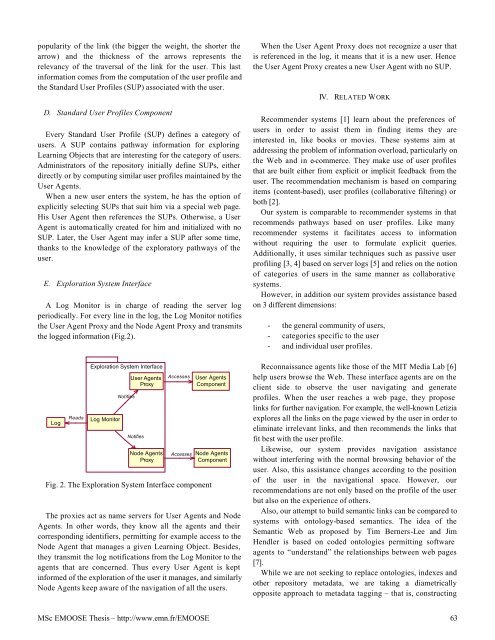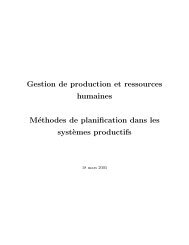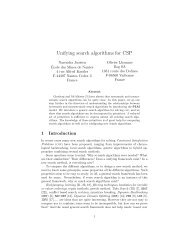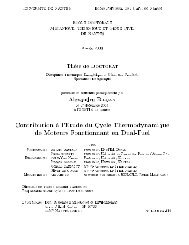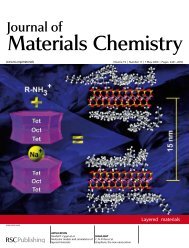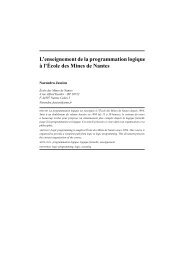pdf - 395 K - Ecole des mines de Nantes
pdf - 395 K - Ecole des mines de Nantes
pdf - 395 K - Ecole des mines de Nantes
You also want an ePaper? Increase the reach of your titles
YUMPU automatically turns print PDFs into web optimized ePapers that Google loves.
popularity of the link (the bigger the weight, the shorter thearrow) and the thickness of the arrows represents therelevancy of the traversal of the link for the user. This lastinformation comes from the computation of the user profile andthe Standard User Profiles (SUP) associated with the user.D. Standard User Profiles ComponentEvery Standard User Profile (SUP) <strong>de</strong>fines a category ofusers. A SUP contains pathway information for exploringLearning Objects that are interesting for the category of users.Administrators of the repository initially <strong>de</strong>fine SUPs, eitherdirectly or by computing similar user profiles maintained by theUser Agents.When a new user enters the system, he has the option ofexplicitly selecting SUPs that suit him via a special web page.His User Agent then references the SUPs. Otherwise, a UserAgent is automatically created for him and initialized with noSUP. Later, the User Agent may infer a SUP after some time,thanks to the knowledge of the exploratory pathways of theuser.E. Exploration System InterfaceA Log Monitor is in charge of reading the server logperiodically. For every line in the log, the Log Monitor notifiesthe User Agent Proxy and the No<strong>de</strong> Agent Proxy and transmitsthe logged information (Fig.2).LogReadsExploration System InterfaceLog MonitorNotifiesUser AgentsProxyNotifiesNo<strong>de</strong> AgentsProxyAccessesAccessesUser AgentsComponentFig. 2. The Exploration System Interface componentNo<strong>de</strong> AgentsComponentThe proxies act as name servers for User Agents and No<strong>de</strong>Agents. In other words, they know all the agents and theircorresponding i<strong>de</strong>ntifiers, permitting for example access to theNo<strong>de</strong> Agent that manages a given Learning Object. Besi<strong><strong>de</strong>s</strong>,they transmit the log notifications from the Log Monitor to theagents that are concerned. Thus every User Agent is keptinformed of the exploration of the user it manages, and similarlyNo<strong>de</strong> Agents keep aware of the navigation of all the users.When the User Agent Proxy does not recognize a user thatis referenced in the log, it means that it is a new user. Hencethe User Agent Proxy creates a new User Agent with no SUP.IV. RELATED WORKRecommen<strong>de</strong>r systems [1] learn about the preferences ofusers in or<strong>de</strong>r to assist them in finding items they areinterested in, like books or movies. These systems aim ataddressing the problem of information overload, particularly onthe Web and in e-commerce. They make use of user profilesthat are built either from explicit or implicit feedback from theuser. The recommendation mechanism is based on comparingitems (content-based), user profiles (collaborative filtering) orboth [2].Our system is comparable to recommen<strong>de</strong>r systems in thatrecommends pathways based on user profiles. Like manyrecommen<strong>de</strong>r systems it facilitates access to informationwithout requiring the user to formulate explicit queries.Additionally, it uses similar techniques such as passive userprofiling [3, 4] based on server logs [5] and relies on the notionof categories of users in the same manner as collaborativesystems.However, in addition our system provi<strong><strong>de</strong>s</strong> assistance basedon 3 different dimensions:- the general community of users,- categories specific to the user- and individual user profiles.Reconnaissance agents like those of the MIT Media Lab [6]help users browse the Web. These interface agents are on theclient si<strong>de</strong> to observe the user navigating and generateprofiles. When the user reaches a web page, they proposelinks for further navigation. For example, the well-known Letiziaexplores all the links on the page viewed by the user in or<strong>de</strong>r toeliminate irrelevant links, and then recommends the links thatfit best with the user profile.Likewise, our system provi<strong><strong>de</strong>s</strong> navigation assistancewithout interfering with the normal browsing behavior of theuser. Also, this assistance changes according to the positionof the user in the navigational space. However, ourrecommendations are not only based on the profile of the userbut also on the experience of others.Also, our attempt to build semantic links can be compared tosystems with ontology-based semantics. The i<strong>de</strong>a of theSemantic Web as proposed by Tim Berners-Lee and JimHendler is based on co<strong>de</strong>d ontologies permitting softwareagents to “un<strong>de</strong>rstand” the relationships between web pages[7].While we are not seeking to replace ontologies, in<strong>de</strong>xes andother repository metadata, we are taking a diametricallyopposite approach to metadata tagging – that is, constructingMSc EMOOSE Thesis – http://www.emn.fr/EMOOSE 63


